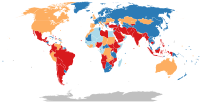
Photo from wikipedia
In December, 2019 the severe acute respiratory syndrome coronavirus 2 (SARS-CoV-2), a novel coronavirus, emerged in China, associated with reported clusters of patients with pneumonia who were epidemiologically linked to… Click to show full abstract
In December, 2019 the severe acute respiratory syndrome coronavirus 2 (SARS-CoV-2), a novel coronavirus, emerged in China, associated with reported clusters of patients with pneumonia who were epidemiologically linked to a seafood and wet live animal market in the city of Wuhan, Hubei Province.1 COVID-19, the term used for the clinical disease caused by SARS-CoV-2, was declared a pandemic by the World Health Organization (WHO) on March 11 ---the first ever caused by a coronavirus.2 As of April 2nd, the number of confirmed cases worldwide has almost reached one million, with 50,000 deaths, and with confirmed cases in almost all countries from all continents.3 The number of reported COVID-19 cases is certainly underestimating the true burden of disease, given the widespread unavailability of tests, and also the significant proportion of persons that, despite being infected, develop asymptomatic or mild unidentified forms of the disease.4 Therefore, we should be careful when calculating the case fatality rates (CFR) of COVID-19 (currently at global rates as high as 5%), acknowledging that these rates will likely be lower once the denominator is adjusted to reflect the true number of individuals who acquired the infection. Seroprevalence studies, once available, will provide information on the proportion of the population that was infected, making possible a more accurate estimation
Journal Title: Jornal De Pediatria
Year Published: 2020
Link to full text (if available)
Share on Social Media: Sign Up to like & get
recommendations!